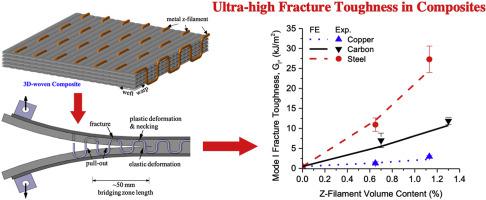当前位置:
X-MOL 学术
›
Compos. Sci. Technol.
›
论文详情
Our official English website, www.x-mol.net, welcomes your
feedback! (Note: you will need to create a separate account there.)
Improving the delamination resistance of fibre reinforced polymer composites using 3D woven metal Z-Filaments
Composites Science and Technology ( IF 8.3 ) Pub Date : 2020-09-01 , DOI: 10.1016/j.compscitech.2020.108301 S. Abbasi , R.B. Ladani , C.H. Wang , A.P. Mouritz
Composites Science and Technology ( IF 8.3 ) Pub Date : 2020-09-01 , DOI: 10.1016/j.compscitech.2020.108301 S. Abbasi , R.B. Ladani , C.H. Wang , A.P. Mouritz

|
Abstract This paper presents a new approach for greatly increasing the delamination resistance of fibre reinforced polymer composites via through-the-thickness weaving of high-strength, high-toughness metal z-filaments. Dry carbon fabric preforms were woven in the through-thickness direction with thin and continuous stainless steel or copper filaments, and then infused with epoxy resin to create 3D woven composites. The modes I and II interlaminar fracture toughness properties of the resultant composites are compared with those of a 3D woven composite reinforced with z-filament made of continuous carbon fibre tows. Experimental testing and finite element modelling of delamination crack growth reveals that metal z-filaments can promote much greater improvements to the mode I interlaminar fracture toughness compared to carbon z-filament. The steel z-filament increases the mode I delamination resistance by over 50 times, with the fracture toughness value (~28 kJ/m2) being the highest reported value for composite laminates. The metal z-filaments are less effective than the carbon z-filament at increasing the mode II delamination resistance, although the improvements are still large. The magnitude of improvements in modes I and II delamination toughness by metal z-filaments depends on several factors, including the alloy type, mechanical properties (e.g. tensile strength and ductility), volume fractions, and crack bridging toughening mechanisms.
中文翻译:

使用 3D 编织金属 Z 长丝提高纤维增强聚合物复合材料的抗分层性
摘要 本文提出了一种通过全厚度编织高强度、高韧性金属 z 长丝来大大提高纤维增强聚合物复合材料的抗分层性的新方法。干碳纤维预制件在厚度方向上用细而连续的不锈钢或铜丝编织,然后注入环氧树脂以创建 3D 编织复合材料。将所得复合材料的模式 I 和 II 层间断裂韧性性能与用连续碳纤维丝束制成的 z 长丝增强的 3D 编织复合材料的性能进行比较。分层裂纹扩展的实验测试和有限元建模表明,与碳 z 细丝相比,金属 z 细丝可以促进 I 型层间断裂韧性的更大改进。钢 z 长丝将 I 型分层阻力提高了 50 倍以上,断裂韧性值 (~28 kJ/m2) 是复合材料层压板的最高报告值。在增加模式 II 抗分层性方面,金属 z 细丝不如碳 z 细丝有效,尽管改进仍然很大。金属 z 长丝在模式 I 和 II 分层韧性方面的改进幅度取决于几个因素,包括合金类型、机械性能(例如拉伸强度和延展性)、体积分数和裂纹桥接增韧机制。在增加模式 II 抗分层性方面,金属 z 细丝不如碳 z 细丝有效,尽管改进仍然很大。金属 z 长丝在模式 I 和 II 分层韧性方面的改进幅度取决于几个因素,包括合金类型、机械性能(例如拉伸强度和延展性)、体积分数和裂纹桥接增韧机制。在增加模式 II 抗分层性方面,金属 z 细丝不如碳 z 细丝有效,尽管改进仍然很大。金属 z 长丝在模式 I 和 II 分层韧性方面的改进幅度取决于几个因素,包括合金类型、机械性能(例如拉伸强度和延展性)、体积分数和裂纹桥接增韧机制。
更新日期:2020-09-01
中文翻译:

使用 3D 编织金属 Z 长丝提高纤维增强聚合物复合材料的抗分层性
摘要 本文提出了一种通过全厚度编织高强度、高韧性金属 z 长丝来大大提高纤维增强聚合物复合材料的抗分层性的新方法。干碳纤维预制件在厚度方向上用细而连续的不锈钢或铜丝编织,然后注入环氧树脂以创建 3D 编织复合材料。将所得复合材料的模式 I 和 II 层间断裂韧性性能与用连续碳纤维丝束制成的 z 长丝增强的 3D 编织复合材料的性能进行比较。分层裂纹扩展的实验测试和有限元建模表明,与碳 z 细丝相比,金属 z 细丝可以促进 I 型层间断裂韧性的更大改进。钢 z 长丝将 I 型分层阻力提高了 50 倍以上,断裂韧性值 (~28 kJ/m2) 是复合材料层压板的最高报告值。在增加模式 II 抗分层性方面,金属 z 细丝不如碳 z 细丝有效,尽管改进仍然很大。金属 z 长丝在模式 I 和 II 分层韧性方面的改进幅度取决于几个因素,包括合金类型、机械性能(例如拉伸强度和延展性)、体积分数和裂纹桥接增韧机制。在增加模式 II 抗分层性方面,金属 z 细丝不如碳 z 细丝有效,尽管改进仍然很大。金属 z 长丝在模式 I 和 II 分层韧性方面的改进幅度取决于几个因素,包括合金类型、机械性能(例如拉伸强度和延展性)、体积分数和裂纹桥接增韧机制。在增加模式 II 抗分层性方面,金属 z 细丝不如碳 z 细丝有效,尽管改进仍然很大。金属 z 长丝在模式 I 和 II 分层韧性方面的改进幅度取决于几个因素,包括合金类型、机械性能(例如拉伸强度和延展性)、体积分数和裂纹桥接增韧机制。











































 京公网安备 11010802027423号
京公网安备 11010802027423号